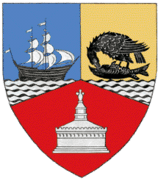Mihail Kogălniceanu, Constanța
| Mihail Kogălniceanu | |
|---|---|
| Commune | |
 Mihail Kogălniceanu Location of Mihail Kogălniceanu, Constanţa | |
| Coordinates: 44°22′0″N 28°27′30″E / 44.36667°N 28.45833°ECoordinates: 44°22′0″N 28°27′30″E / 44.36667°N 28.45833°E | |
| Country |
|
| County | Constanţa County |
| Status | Commune |
| Component villages | Mihail Kogălniceanu, Palazu Mic, Piatra |
| Government | |
| • Mayor | Ancuţa-Daniela Belu[1] (National Liberal Party) |
| Area | |
| • Total | 165.51 km2 (63.90 sq mi) |
| Population (2011[2]) | |
| • Total |
|
| Time zone | EET (UTC+2) |
| • Summer (DST) | EEST (UTC+3) |
| Website | http://www.mk-primaria.ro |
Mihail Kogălniceanu (Romanian pronunciation: [mihaˈil koɡəlniˈt͡ʃe̯anu]) is a commune in Constanţa County, Romania, and is located 25 km (16 mi) northwest of Constanţa proper. The commune includes three villages:
- Mihail Kogălniceanu - historical names: Kara Murat (Turkish: Karamurat), Bulgari (Bulgarian: Българи) and Regele Ferdinand
- Palazu Mic
- Piatra (historical name: Taşaul, Turkish: Taşağıl)
The commune further includes two territorially distinct communities, Social Group Sibioara and Social Group Ceres, which are legally part of the village of Mihail Kogălniceanu. The Mihail Kogălniceanu International Airport is located nearby.
History
The village is situated on the location of a Roman settlement called Vicus Clementianus, discovered by the archaeologist Vasile Pârvan in 1913.
In 1651, the place was mentioned by the Ottoman traveler Evliya Çelebi as a Tatar settlement named Kara Murat ("Black Murat", after its founder).
In 1879-1880, after the incorporation of Northern Dobruja into Romania, the village started to be settled by Romanian shepherds from Transylvania (mocani). In the 1930s it was re-baptized Ferdinand I, after King Ferdinand I of Romania. In 1948, with the advent of the communist regime, the commune was given its current name, after the Romanian politician Mihail Kogălniceanu.
Demographics
At the 2011 census, Mihail Kogălniceanu had 8,273 Romanians (84.95%), 3 Hungarians (0.03%), 246 Roma (2.53%), 3 Germans (0.03%), 33 Turks (0.34%), 419 Tatars (4.30%), 108 Aromanians (1.11%), 642 others (6.59%), 12 with undeclared ethnicity (0.12%).[2]
References
- ↑ "Luptă strânsă pentru Consiliul Judeţean Constanţa între PSD şi PNL. Noua garnitură de primari" (in Romanian). Ziua de Constanța. 7 June 2016. Retrieved 7 June 2016.
- 1 2 "Constanta County at the 2011 census" (PDF) (in Romanian). INSSE. February 2, 2012. Retrieved March 8, 2012.
External links
- "Romanians Eager for Long-Awaited Arrival of the Yanks", Kevin Sullivan, The Washington Post, February 6, 2006
